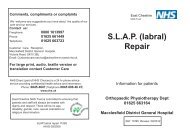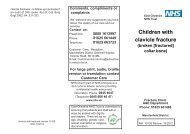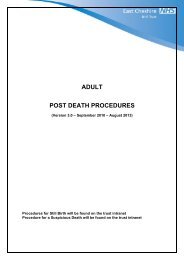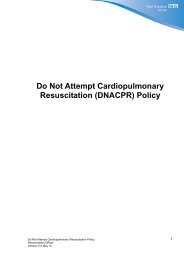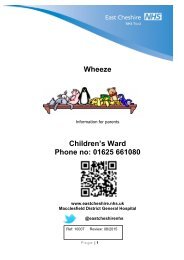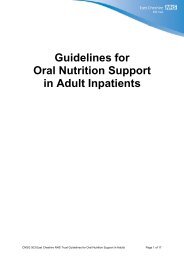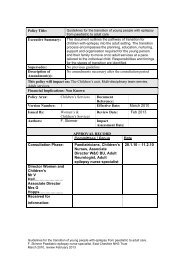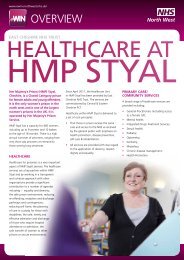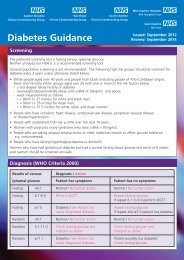Paediatrics Vital Signs and PEWS 1854.pdf - East Cheshire NHS Trust
Paediatrics Vital Signs and PEWS 1854.pdf - East Cheshire NHS Trust
Paediatrics Vital Signs and PEWS 1854.pdf - East Cheshire NHS Trust
Create successful ePaper yourself
Turn your PDF publications into a flip-book with our unique Google optimized e-Paper software.
National Institue for Health <strong>and</strong> Clinical Excellence (2011)Head injury Triage, assessment,investigation <strong>and</strong> early management of head injury in infants, children <strong>and</strong> adults, London:NICE http://www.nice.org.uk/nicemedia/pdf/CG56NICEGuideline.pdf<strong>NHS</strong> Institute for Innovation <strong>and</strong> Improvement (2011) Situation, background, assessmentrecommendation,London: NIII.http://www.institute.nhs.uk/safer_care/safer_care/Situation_Background_Assessment_Recommendation.htmlNursing <strong>and</strong> Midwifery Council (2004) The NMC code of professional conduct: st<strong>and</strong>ards forconduct, performance <strong>and</strong> ethics, London: NMCRoyal College of Nursing (2011) St<strong>and</strong>ards for assessing, measuring <strong>and</strong> monitoring vital signsin infants, children <strong>and</strong> young people, London: RCN.Appendix 2 –Equality <strong>and</strong> Human Rights Policy Screening ToolEquality Analysis (Impact assessment)Please START this assessment BEFORE writing your policy, procedure, proposal, strategy or service sothat you can identify any adverse impacts <strong>and</strong> include action to mitigate these in your finished policy,procedure, proposal, strategy or service. Use it to help you develop fair <strong>and</strong> equal services.Eg. If there is an impact on Deaf people, then include in the policy how Deaf people will have equalaccess.1. What is being assessed?Procedure for assessing <strong>and</strong> measuring vital signs on Paediatric Patients <strong>and</strong> usingthe Paediatric Early warning scoreDetails of person responsible for completing the assessment: Name: Joanne Shippey Position: Paediatric Practice Development Nurse Team/service: Paediatric WardState main purpose or aim of the policy, procedure, proposal, strategy or service:(usually the first paragraph of what you are writing. Also include details of legislation, guidance,regulations etc which have shaped or informed the document)This document outlines guidance for the paediatric unit on assessing <strong>and</strong> measuring vital signs <strong>and</strong> using thepaediatric early warning score2. Consideration of Data <strong>and</strong> ResearchTo carry out the equality analysis you will need to consider information about the people who use theservice <strong>and</strong> the staff that provide it. Think about the information below – how does this apply to yourpolicy, procedure, proposal, strategy or service2.1 Give details of RELEVANT information available that gives you an underst<strong>and</strong>ing of who willbe affected by this documentThe population of <strong>Cheshire</strong> as at the 2005 mid year figures (Cohesia Report 2008) is 684,400.Age:M<strong>PEWS</strong> guidelinesJ ShippeyJanuary 2011, Review December 20136
17.8% (30,500) of the population in <strong>Cheshire</strong> <strong>East</strong> is over 65 compared with 15.9%nationally. This results in a high “old age” dependency ratio, i.e. low numbers ofworking-age people supporting a high non-working dependant older population. Thepercentage of “older” or “frail” old is also considerably higher, with 2.3% (8,200)persons 85 <strong>and</strong> over compared to 2.1% nationally.<strong>Cheshire</strong> <strong>East</strong> has the fastest growing older population in the North West. By 2016, thepopulation aged 65+ will increase by 29.0% (8,845) <strong>and</strong> the population aged 85+ by41.5% (3,403).This will have an impact on the number of patients being managed by ECT <strong>and</strong> thecomplexity of the health <strong>and</strong> social care issues that the older person is experiencing. Inaddition the staffing profile of ECT will change to include an increasing number of staffover 65 in the workforce.Race:The 2005 mid year estimate (Cohesia Report 2008) show that the majority of the population in<strong>Cheshire</strong>(94.6%) is White British, with 5.4% non White British. The <strong>Cheshire</strong> 2007-10 Local AreaAgreementidentified that minority ethnic communities account for around 3% of the population. Issues forBME communities include lack of knowledge of services, access to services, access totranslation/interpretation, cultural differences, family values. Many people from BMEcommunities experience poverty, poor housing <strong>and</strong> unemployment which make itdifficult for them to lead healthier lives. 4180 migrant workers registered in <strong>Cheshire</strong> in2006/07 <strong>and</strong> comparison to the mid- year population estimates for <strong>Cheshire</strong> in 2005strongly suggests that <strong>Cheshire</strong>’s migrant worker population is larger than everyindividual BME group other than the White-Other White group.Gypsies <strong>and</strong> travellers – at the last count (July 2006) the highest number was recordedin the Borough of Congleton (125). 42% of gypsies <strong>and</strong> travellers report limiting longterm illness compared to 18% of the settled population, with an average life expectancy10-12 years less than settled population. 18% of gypsy <strong>and</strong> traveller mothers haveexperienced the death of a child compared to 1% in the settled population.Disability:There are over 10 million disabled people in Britain, of whom 5 million are over statepension age. Nearly 1 in 5 people of working age (7 million, or 18.6%) in Great Britainhave a disability.Hearing loss: 1 in 4 has a hearing problem.Sight problems: There are 2 million people with sight problems in the UK.Learning disabilities: There is quite a high proportion of people with learning disabilitiesin the local area due to there being a number of residential homes/institutions in thearea.Problems encountered can be lack of staff awareness, communication issues,information requirements.DementiaApproximately six in 100 people aged over 65 develop dementia <strong>and</strong> this rises toaround 20 in 100 people aged 85 or over. Dementia affects 750,000 people in the UK.M<strong>PEWS</strong> guidelinesJ ShippeyJanuary 2011, Review December 20137
CarersAround 6 million people (11 per cent of the population aged 5+) provided unpaid care inthe UK in April 2001. While 45% of carers were aged between 45 <strong>and</strong> 64, a number ofthe very young <strong>and</strong> very old also provided care. By 2037, it is anticipated that thenumber of carers will increase to 9 million.GenderOn average in <strong>Cheshire</strong>, 49% of the population are male <strong>and</strong> 51% are femaleTransgender: No local data available, national trends show:1/12,000 males, transgender from male to female1/33,000 females, transgender from female to maleSpecific issues around access to services, specific services for men or women, <strong>and</strong>‘single sex’ facilities. In terms of the transgender population, GIRES (Gender IdentityResearch <strong>and</strong> Education Society ) gives an estimate of 600 per 100,000. If these figures wereapplied to the <strong>Cheshire</strong> <strong>East</strong> community based on the 2005 mid year estimates, there may bearound 2,100 trans people in the area.Religion/BeliefIn the <strong>Cheshire</strong> <strong>East</strong> area:Christian - 80% Sikh - 0.05%Buddhists - 0.16% Other religion - 0.15%Hindu - 0.15% No religion - 11.84%Jewish - 0.12% Not stated - 6.67%Muslim - 0.36%The Muslim population has the highest levels of ill health amongst faith groups – thisincludes higher smoking rates amongst men <strong>and</strong> higher rates of coronary heart disease<strong>and</strong> diabetes.Sexual OrientationLesbians, gay men <strong>and</strong> bi sexual people (LGB) make up to 5-7% of the UK population(Dept of Trade <strong>and</strong> Industry, 2003). 13% of Gay men <strong>and</strong> 31% Lesbian women areparents (Morgan <strong>and</strong> Bell, First Out: Report of the findings of Beyond the Barriersnational survey of LGB people)The experience <strong>and</strong> health needs of gay men <strong>and</strong> women will differ. However, bothgroups are likely to experience discrimination, higher levels of mental ill health <strong>and</strong>barriers to accessing health careNational Health Inequalities data shows that lesbian, gay, bisexual <strong>and</strong> transgender(LGBT) people are e 2001 census showed:significantly more likely to smoke, to have higher levels of alcohol use <strong>and</strong> to have useda range of recreational drugs than heterosexual people. They are also at greater risk ofdeliberate self-harm. Although most LGBT people do not experience poor mentalhealth, research suggests that some are at higher risk of mental health disorder,suicidal behaviour <strong>and</strong> substance misuse2.2 Evidence of complaints on grounds of discrimination: (Are there any complaints or concernsraised either from patients or staff (grievance) relating to the policy, procedure, proposal, strategy orservice or its effects on different groups?)None: It offers guidance for measuring clinical observations on the ward. All patients will have theseobservations regardless of age, gender, race, religion or sexual orientationM<strong>PEWS</strong> guidelinesJ ShippeyJanuary 2011, Review December 20138
2.3 Does the information gathered from 2.1 – 2.3 indicate any negative impact as a result of thisdocument?No3. Assessment of ImpactNow that you have looked at the purpose, etc. of the policy, procedure, proposal, strategy or service(part 1) <strong>and</strong> looked at the data <strong>and</strong> research you have (part 2), this section asks you to assess the impactof the policy, procedure, proposal, strategy or service on each of the str<strong>and</strong>s listed below.RACE:From the evidence available does the policy, procedure, proposal, strategy or service affect, or havethe potential to affect, racial groups differently? Yes No xExplain your response:It offers guidance for checking clinical observations on the ward. All patients will have theseobservations regardless of race. Any explanations to parents <strong>and</strong> children whose first language is notEnglish will be carried out using the <strong>Trust</strong>’s interpretation <strong>and</strong> translation policy. Also, the Unit has apicture communications book in the ward communications aids box.GENDER (INCLUDING TRANSGENDER):From the evidence available does the policy, procedure, proposal, strategy or service affect, or havethe potential to affect, different gender groups differently? Yes No xExplain your response:It offers guidance for checking clinical observations on the ward. All patients will have theseobservations regardless of gender.DISABILITY From the evidence available does the policy, procedure, proposal, strategy or serviceaffect, or have the potential to affect, disabled people differently? Yes No xExplain your response:Some children/parents with disability may need further explanation when undertaking these observations<strong>and</strong> reasonable adjustments may need to be made in order for the procedures to be tolerated by the child.Similarly, patients with disability may have different baseline for the parameters of observations whichshould be taken into account <strong>and</strong> identified through discussion with the patient , parent/carer or throughtheir patient passport. If necessary the <strong>Trust</strong>’s interpretation <strong>and</strong> translation policy <strong>and</strong> the picturecommunications aids box can be utilised. For patients with learning disabilities, the health facilitatorfrom CWP can be involved.AGE:From the evidence available does the policy, procedure, proposal, strategy or service, affect, or havethe potential to affect, age groups differently? Yes No xExplain your response:This guideline is only applicable to childrenLESBIAN, GAY, BISEXUAL:From the evidence available does the policy, procedure, proposal, strategy or service affect, or havethe potential to affect, lesbian, gay or bisexual groups differently? Yes No xExplain your response:_ It offers guidance for checking clinical observations on the ward. All patients will have theseobservations regardless of sexual orientationRELIGION/BELIEF:From the evidence available does the policy, procedure, proposal, strategy or service affect, or havethe potential to affect, religious belief groups differently? Yes No xM<strong>PEWS</strong> guidelinesJ ShippeyJanuary 2011, Review December 20139
Explain your response:It offers guidance for checking clinical observations on the ward. All patients will have theseobservations regardless of religion/belief.CARERS:From the evidence available does the policy, procedure, proposal, strategy or service affect, or havethe potential to affect, carers differently? Yes No xExplain your response:It offers guidance for checking clinical observations on the ward. All patients will have theseobservations regardless of whether they are a young carer. Parents <strong>and</strong> carers will be involved inexplanations about the equipment <strong>and</strong> decisions about treatment.OTHER: EG Pregnant women, people in civil partnerships, human rights issues.From the evidence available does the policy, procedure, proposal, strategy or service affect, or havethe potential to affect any other groups differently? Yes No xExplain your response: No other impacts identified4. Safeguarding Assessment - CHILDRENa. Is there a direct or indirect impact upon children? Yes x No b. If yes please describe the nature <strong>and</strong> level of the impact (consideration to be given to all children;children in a specific group or area, or individual children. As well as consideration of impact now orin the future; competing / conflicting impact between different groups of children <strong>and</strong> young people:This guideline offers guidance for the undertaking of clinical observations <strong>and</strong> the paediatric earlywarning score for patients on the children’s ward. Therefore there is a positive impact on all children<strong>and</strong> young people on the ward.c. If no please describe why there is considered to be no impact / significant impact on children5. Relevant consultationHaving identified key groups, how have you consulted with them to find out their views <strong>and</strong> that the madesure that the policy, procedure, proposal, strategy or service will affect them in the way that youintend? Have you spoken to staff groups, charities, national organisations etc?All relevant staff groups have had the opportunity to read <strong>and</strong> comment on this policy.Policy has been amended to reflect their opinions6. Date completed: Review Date:7. Any actions identified: Have you identified any work which you will need to do in the futureto ensure that the document has no adverse impact?Action Lead Date to be Achieved1. Ensure all staff have been on learning disability awarenesstrainingAll staff attend anually2. Ensure all staff aware of communications box <strong>and</strong> contentsThis is coveredby <strong>Paediatrics</strong>The Essentialswhich all staffattend annually8. Approval – At this point, you should forward the template to the <strong>Trust</strong> Equality <strong>and</strong>Diversity Lead lynbailey@nhs.netM<strong>PEWS</strong> guidelinesJ ShippeyJanuary 2011, Review December 201310
Approved by <strong>Trust</strong> Equality <strong>and</strong> Diversity Lead:Date:15.2.13M<strong>PEWS</strong> guidelinesJ ShippeyJanuary 2011, Review December 201311





